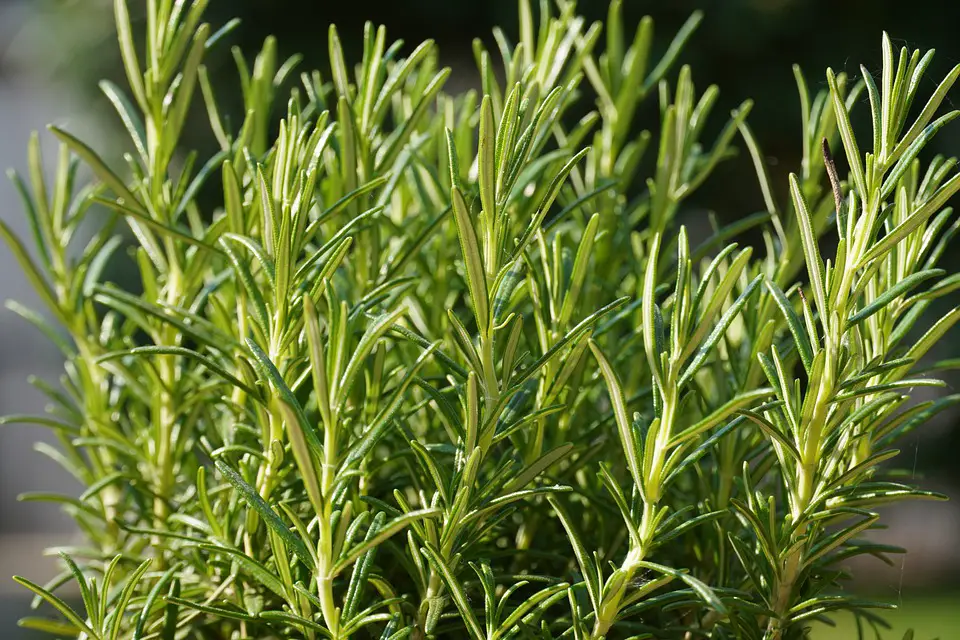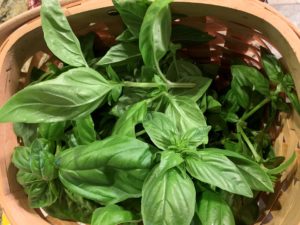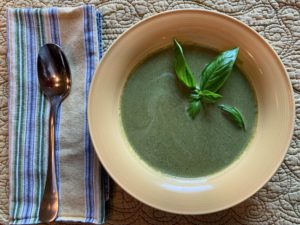Rosemary is a beautiful, fragrant herb that originated in the Mediterranean. Like lavender, thyme, oregano, and basil, it is a member of the mint family.
This low-maintenance shrub has slender, needle-like leaves that grow on woody stems. It can reach between two and six feet (.6 and 1.8 meters) tall and two to four feet (.6 and 1.2 meters) wide, depending on the variety. It blooms in the late spring to early summer, starting in its second season. The small white to light blue flowers grow in clusters and are a favorite of bees, wasps, and other pollinators. In zones 8 to 11, it is considered a perennial, however, in zones 1 to 7, it acts more like an annual because of the cold temperatures.
This article contains affiliate links. If you make a purchase using one of these links, I will receive a very small commission at no additional cost to you, and it will help me maintain this website. Rest assured, I only recommend products I actually like!
Rosemary is often used to add a distinctive flavor to poultry, lamb, potatoes, soups, and stews. Its essential oil is used to improve memory, treat hair loss, and lower cortisol, among other things. It has also been studied for its anti-cancer and anti-inflammatory properties.
Rosemary makes a good companion plant for carrots, cabbage, beans, broccoli, and sage as its fragrance repels some pests, like the bean beetle, cabbage moth, and carrot fly.
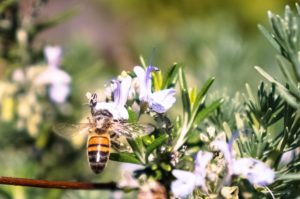
How to Grow Rosemary From Seed
Like lavender, rosemary can sometimes be challenging to start from seed, but that does not mean that you shouldn’t try. I have done it and you can, too! Two to three months before your area’s last spring frost date, plant several seeds in fresh potting mix in starter pots. Plant more than you think you will need in order to improve your chances of success. Lightly cover the seeds with potting mix and water gently. Place the pots in a tray under a grow light and a heat mat so that the soil will stay warm. A temperature of 80-90º F (27-32°C) is ideal. Seeds can take up to three weeks to germinate, so you will need to be patient. Once the seedlings are established, you can begin watering from below to minimize the risk of getting fungus gnats.
When the seedlings are three inches or taller and the outdoor soil temperature is around 80ºF (27°C), you can harden off the seedlings in preparation for outdoor life.
How to Propagate Rosemary From a Cutting
Another way to grow rosemary is to propagate it. In the spring or summer, cut a healthy sprig with a soft stem, 4 to 6 inches (10 to 15 cm) long. Remove the leaves from the lower portion of the stem and place the sprig in moistened potting mix. Some like to dip the cut end in a root stimulant before planting, and while helpful, it is not always necessary. Place the cutting in a warm location that gets several hours of sunlight or under a grow light. Keep the soil moist but not soggy. You do not want to let the potting mix dry out. The cutting should develop roots in about two to three weeks. One way to check to see if the cutting has rooted is to gently tug on the sprig. If you feel resistance, that is a good sign that the cutting has developed roots. You can now transplant the cutting. If you live in zone 8 or warmer, you can also plant rosemary in the fall.
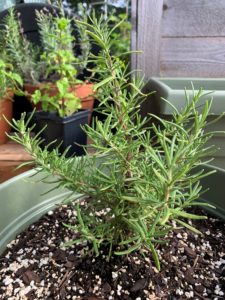
Sun and Soil
You can grow rosemary in the ground, in raised beds, or containers. It requires at least six hours of full sun. This Mediterranean staple thrives in warm weather and prefers low humidity. If you live in zone 7 or colder, you can grow rosemary in containers indoors, provided it receives adequate light. Otherwise, the stems will become leggy.
Rosemary will flourish when planted in well-draining sandy to loamy soil with a soil pH of 6.0 to 7.0. It can grow in lesser conditions, but it will not do as well.
Water
Like oregano and thyme, mature rosemary plants are drought tolerant. Water the plant well when the top few inches of soil are dry to the touch. High humidity and overwatering can lead to problems like fungal diseases. To prevent this, make sure there is adequate circulation between plants and be careful not to overwater.
Fertilizer
Rosemary plants are not heavy feeders and may only require adding compost in the spring. However, if growing in containers, you may need to add an organic granular fertilizer in the spring or an organic liquid fertilizer on occasion.
Pruning and Repotting
Remember, rosemary is a shrub, so whether it is growing in the ground or a container, you will need to prune it from time to time, especially if you are not harvesting sprigs regularly. Wait until after the plant has bloomed and cut no more than 1/3 of the plant at a time.
If you are growing in containers, you will need to repot the plant to a larger container each year in the spring. Be sure to place the plant in the new container at the same depth as the previous one. Terra cotta pots are a good choice because they are porous and help the plant dry out in-between watering. Use fresh or rejuvenated potting mix to ensure a healthy transition.
How to Harvest and Preserve Rosemary
Like other herbs, rosemary can be harvested throughout the year, but the sprigs will be most flavorful if cut during the growing season and before the plant flowers. Do not harvest more than 1/3 of the plant at any given time.
There are a number of ways you can preserve the harvest. One method is to dehydrate the harvested sprigs by tying them in bunches and hanging them upside down in a dry place. Or, for a faster and more convenient method, use a dehydrator set between 95ºF and 115ºF (35ºC and 46ºC). Once the sprigs are dry, remove the leaves from the stem and store them in a spice jar or other container with a tight-fitting seal to keep the moisture out.
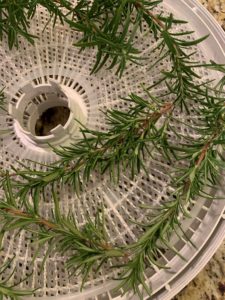
You can also preserve rosemary by freezing it. Line a cookie sheet with parchment paper and lay the sprigs on the paper so that they are not touching one another. Place them in the freezer. When frozen, remove the leaves from the stems and store them in a freezer-grade plastic bag or another airtight container in the freezer.
Alternatively, you can freeze rosemary leaves in ice cube trays filled 3/4 full with water or olive oil. Once frozen, remove the cubes and store them in a freezer-grade baggie in the freezer.
Pests
Here are some of the pests that may afflict rosemary:
Whiteflies are tiny white or cream-colored insects that resemble miniature moths. These soft-bodied insects gather in groups, usually on the underside of leaves, often near the leaf veins. The adult flies are covered in white mealy wax, from which they derive their names. They suck the plant’s sap, causing the leaves to wilt and turn yellow, thus, weakening the plant. They also excrete a sticky substance called honeydew, which then provides a breeding ground for sooty mold. The mold, in turn, can inhibit photosynthesis and eventually kill the plant. To learn more about whiteflies and how to eliminate them organically, check out this helpful article.
Aphids are very small, soft-bodied insects that, like whiteflies, zap a plant’s vitality by sucking the sap. They also excrete honeydew which can attract other insects. Aphids are also vectors for various plant diseases, which can threaten your plant’s productivity and life. To learn more about aphids and how to get rid of them organically, check out this article.
Spider Mites measure only about 1/50 of an inch long, which makes them very hard to see. Like aphids and whiteflies, they, too, suck the sap out of plants. You may notice yellow or brown leaves or ones that look dull or dusty. Leaves may also be stippled or curled. You may also see fine webbing in between the leaf and stem or on the underside of leaves.
Spider mites multiply quickly, so you need to act at the first sign. The first step is to dislodge them with a strong stream of water. Next, treat the plant with an organic insecticidal soap. You can make your own by mixing 1 to 2 teaspoons of a Castile soap like Dr. Bonner’s or Dr. Wood’s in one quart of water (or 1 tablespoon in one gallon of water). Do a test spray on one leaf and wait 24 to 48 hours to see how the plant responds. If it shows signs of damage, dilute the mixture and perform another test spray. Spray the entire plant, including the underside of leaves, in the cool of the evening or early in the morning. Otherwise, the combination of the spray and sunlight could burn the plant. Repeat every 7 days.
Ladybugs and lacewings are natural predators of spider mites and other garden pests. You can learn more about this micro pest in this helpful article.

Mealybugs have segmented, oval bodies with fringe-like hairs around the perimeter. They are small, measuring between 1/10 inch to 1/4 inch long, and covered with a white or gray wax that looks like ground meal, hence their name. They produce a cotton-like substance that keeps them from drying out from the heat, which also offers protection for the eggs. Mealybug nymphs are pale pink, yellow, or orange and are not covered in wax. Like the previously mentioned pests, these tiny white insects are sap-sucking, honeydew producers that attack a wide variety of plants and fruit trees. Learn more about this pest and how to treat it in this article.
Mealybugs are often confused with the larvae of the mealybug destroyer, a beneficial bug that, as its name suggests, kills mealybugs.
Spittlebugs measure about 1/4 inch in length (.65 cm). They derive their name from the spittle or frothy, bubbly liquid they produce and which serves to protect them from predators and unfavorable temperatures. The spittle, however, is actually urine and not saliva.
Spittlebugs are also sap-suckers, but they do not pose much of a problem if they are few in number. Both the spittle and the nymphs can be removed by spraying them with a strong stream of water. However, if present in sufficient numbers, they can cause plant damage. If so, treat them the same way you would the other sap-sucking insects.
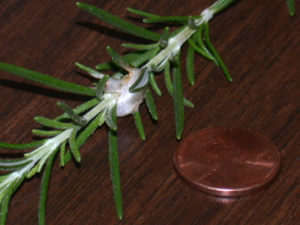
Diseases
Rosemary, although hardy, is not exempt from disease. Here are some of the more common pathogens that can affect it.
Powdery mildew and downy mildew are fungal and fungal-like diseases that can plague rosemary. Both are the result of wet or humid environments with insufficient air circulation between plants. While the pathogens cannot be fully eradicated, they can be controlled if treatment begins early. Learn more about these diseases and how to treat them in these helpful articles: powdery mildew, downy mildew, and how to tell the difference between them.
Aerial Blight, also known as web blight, is a fungus that develops in wet conditions. The infection observed on stems includes yellow spots and patchy leaf growth. Blight causes the decline and potentially the death of the plant. To prevent infection, water management is key as high humidity, overwatering, poor drainage, too much shade, and poor circulation promote the condition. Excessive use of fertilizer can also contribute to unhealthy conditions that encourage blight.
Root rot is a condition caused by overwatering and or poor drainage. Roots that remain damp or water-logged will rot, often resulting in the death of the plant. Symptoms of root rot include limp leaves and dying stems because the rotten roots are unable to transport nutrients to the plant. It may be possible to salvage the plant by digging it up and pruning any affected roots. However, if the root system is soggy and black, it is too late, and you will need to throw it away.
Varieties
There are several rosemary varieties available to grow. Here are some of the more popular ones:
Golden Rain is a compact variety that grows to a height and width of 2 to 3 feet (.61 to .91 meters). It receives its name because of the yellow markings on its foliage.
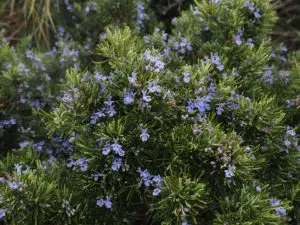
Blue Boy is a compact, slow-growing variety that is well-suited for containers. It grows to a height of 2 feet (.61 meters) and has pale blue flowers.
Arp is a variety of rosemary that is cold-hardy. It was named after the small Texas town of Arp. This variety reaches 4 feet tall (1.22 meters), is easy to grow, and is one of the more fragrant varieties.
Albus or White Rosemary puts out white flowers and grows to a height of about 3 feet (.91 meters)
You might also be interested in Creeping Rosemary, Prostratus, Miss Jessup, Spice Island, and Tuscan varieties.
Rosemary is a hardy, drought-tolerant shrub whose leaves offer a distinctive herbal scent and flavor. Overall, it is easy to grow and care for, and it makes a perfect addition to any herb or vegetable garden.
(You can learn more about why rosemary leaves turn yellow in this helpful article.)
Thank you for reading this article! If you found it helpful, please consider sharing it with others via email and social media!
Rosemary is a beautiful, fragrant herb that originated in the Mediterranean. Like lavender, thyme, oregano, and basil, it is a member of the mint family.
This low-maintenance shrub has slender, needle-like leaves that grow on woody stems. It can reach between two and six feet (.6 and 1.8 meters) tall and two to four feet (.6 and 1.2 meters) wide, depending on the variety. It blooms in the late spring to early summer, starting in its second season. The small white to light blue flowers grow in clusters and are a favorite of bees, wasps, and other pollinators. In zones 8 to 11, it is considered a perennial, however, in zones 1 to 7, it acts more like an annual because of the cold temperatures.
This article contains affiliate links. If you make a purchase using one of these links, I will receive a very small commission at no additional cost to you, and it will help me maintain this website. Rest assured, I only recommend products I actually like!
Rosemary is often used to add a distinctive flavor to poultry, lamb, potatoes, soups, and stews. Its essential oil is used to improve memory, treat hair loss, and lower cortisol, among other things. It has also been studied for its anti-cancer and anti-inflammatory properties.
Rosemary makes a good companion plant for carrots, cabbage, beans, broccoli, and sage as its fragrance repels some pests, like the bean beetle, cabbage moth, and carrot fly.

How to Grow Rosemary From Seed
Like lavender, rosemary can sometimes be challenging to start from seed, but that does not mean that you shouldn’t try. I have done it and you can, too! Two to three months before your area’s last spring frost date, plant several seeds in fresh potting mix in starter pots. Plant more than you think you will need in order to improve your chances of success. Lightly cover the seeds with potting mix and water gently. Place the pots in a tray under a grow light and a heat mat so that the soil will stay warm. A temperature of 80-90º F (27-32°C) is ideal. Seeds can take up to three weeks to germinate, so you will need to be patient. Once the seedlings are established, you can begin watering from below to minimize the risk of getting fungus gnats.
When the seedlings are three inches or taller and the outdoor soil temperature is around 80ºF (27°C), you can harden off the seedlings in preparation for outdoor life.
How to Propagate Rosemary From a Cutting
Another way to grow rosemary is to propagate it. In the spring or summer, cut a healthy sprig with a soft stem, 4 to 6 inches (10 to 15 cm) long. Remove the leaves from the lower portion of the stem and place the sprig in moistened potting mix. Some like to dip the cut end in a root stimulant before planting, and while helpful, it is not always necessary. Place the cutting in a warm location that gets several hours of sunlight or under a grow light. Keep the soil moist but not soggy. You do not want to let the potting mix dry out. The cutting should develop roots in about two to three weeks. One way to check to see if the cutting has rooted is to gently tug on the sprig. If you feel resistance, that is a good sign that the cutting has developed roots. You can now transplant the cutting. If you live in zone 8 or warmer, you can also plant rosemary in the fall.

Sun and Soil
You can grow rosemary in the ground, in raised beds, or containers. It requires at least six hours of full sun. This Mediterranean staple thrives in warm weather and prefers low humidity. If you live in zone 7 or colder, you can grow rosemary in containers indoors, provided it receives adequate light. Otherwise, the stems will become leggy.
Rosemary will flourish when planted in well-draining sandy to loamy soil with a soil pH of 6.0 to 7.0. It can grow in lesser conditions, but it will not do as well.
Water
Like oregano and thyme, mature rosemary plants are drought tolerant. Water the plant well when the top few inches of soil are dry to the touch. High humidity and overwatering can lead to problems like fungal diseases. To prevent this, make sure there is adequate circulation between plants and be careful not to overwater.
Fertilizer
Rosemary plants are not heavy feeders and may only require adding compost in the spring. However, if growing in containers, you may need to add an organic granular fertilizer in the spring or an organic liquid fertilizer on occasion.
Pruning and Repotting
Remember, rosemary is a shrub, so whether it is growing in the ground or a container, you will need to prune it from time to time, especially if you are not harvesting sprigs regularly. Wait until after the plant has bloomed and cut no more than 1/3 of the plant at a time.
If you are growing in containers, you will need to repot the plant to a larger container each year in the spring. Be sure to place the plant in the new container at the same depth as the previous one. Terra cotta pots are a good choice because they are porous and help the plant dry out in-between watering. Use fresh or rejuvenated potting mix to ensure a healthy transition.
How to Harvest and Preserve Rosemary
Like other herbs, rosemary can be harvested throughout the year, but the sprigs will be most flavorful if cut during the growing season and before the plant flowers. Do not harvest more than 1/3 of the plant at any given time.
There are a number of ways you can preserve the harvest. One method is to dehydrate the harvested sprigs by tying them in bunches and hanging them upside down in a dry place. Or, for a faster and more convenient method, use a dehydrator set between 95ºF and 115ºF (35ºC and 46ºC). Once the sprigs are dry, remove the leaves from the stem and store them in a spice jar or other container with a tight-fitting seal to keep the moisture out.

You can also preserve rosemary by freezing it. Line a cookie sheet with parchment paper and lay the sprigs on the paper so that they are not touching one another. Place them in the freezer. When frozen, remove the leaves from the stems and store them in a freezer-grade plastic bag or another airtight container in the freezer.
Alternatively, you can freeze rosemary leaves in ice cube trays filled 3/4 full with water or olive oil. Once frozen, remove the cubes and store them in a freezer-grade baggie in the freezer.
Pests
Here are some of the pests that may afflict rosemary:
Whiteflies are tiny white or cream-colored insects that resemble miniature moths. These soft-bodied insects gather in groups, usually on the underside of leaves, often near the leaf veins. The adult flies are covered in white mealy wax, from which they derive their names. They suck the plant’s sap, causing the leaves to wilt and turn yellow, thus, weakening the plant. They also excrete a sticky substance called honeydew, which then provides a breeding ground for sooty mold. The mold, in turn, can inhibit photosynthesis and eventually kill the plant. To learn more about whiteflies and how to eliminate them organically, check out this helpful article.
Aphids are very small, soft-bodied insects that, like whiteflies, zap a plant’s vitality by sucking the sap. They also excrete honeydew which can attract other insects. Aphids are also vectors for various plant diseases, which can threaten your plant’s productivity and life. To learn more about aphids and how to get rid of them organically, check out this article.
Spider Mites measure only about 1/50 of an inch long, which makes them very hard to see. Like aphids and whiteflies, they, too, suck the sap out of plants. You may notice yellow or brown leaves or ones that look dull or dusty. Leaves may also be stippled or curled. You may also see fine webbing in between the leaf and stem or on the underside of leaves.
Spider mites multiply quickly, so you need to act at the first sign. The first step is to dislodge them with a strong stream of water. Next, treat the plant with an organic insecticidal soap. You can make your own by mixing 1 to 2 teaspoons of a Castile soap like Dr. Bonner’s or Dr. Wood’s in one quart of water (or 1 tablespoon in one gallon of water). Do a test spray on one leaf and wait 24 to 48 hours to see how the plant responds. If it shows signs of damage, dilute the mixture and perform another test spray. Spray the entire plant, including the underside of leaves, in the cool of the evening or early in the morning. Otherwise, the combination of the spray and sunlight could burn the plant. Repeat every 7 days.
Ladybugs and lacewings are natural predators of spider mites and other garden pests. You can learn more about this micro pest in this helpful article.

Mealybugs have segmented, oval bodies with fringe-like hairs around the perimeter. They are small, measuring between 1/10 inch to 1/4 inch long, and covered with a white or gray wax that looks like ground meal, hence their name. They produce a cotton-like substance that keeps them from drying out from the heat, which also offers protection for the eggs. Mealybug nymphs are pale pink, yellow, or orange and are not covered in wax. Like the previously mentioned pests, these tiny white insects are sap-sucking, honeydew producers that attack a wide variety of plants and fruit trees. Learn more about this pest and how to treat it in this article.
Mealybugs are often confused with the larvae of the mealybug destroyer, a beneficial bug that, as its name suggests, kills mealybugs.
Spittlebugs measure about 1/4 inch in length (.65 cm). They derive their name from the spittle or frothy, bubbly liquid they produce and which serves to protect them from predators and unfavorable temperatures. The spittle, however, is actually urine and not saliva.
Spittlebugs are also sap-suckers, but they do not pose much of a problem if they are few in number. Both the spittle and the nymphs can be removed by spraying them with a strong stream of water. However, if present in sufficient numbers, they can cause plant damage. If so, treat them the same way you would the other sap-sucking insects.

Diseases
Rosemary, although hardy, is not exempt from disease. Here are some of the more common pathogens that can affect it.
Powdery mildew and downy mildew are fungal and fungal-like diseases that can plague rosemary. Both are the result of wet or humid environments with insufficient air circulation between plants. While the pathogens cannot be fully eradicated, they can be controlled if treatment begins early. Learn more about these diseases and how to treat them in these helpful articles: powdery mildew, downy mildew, and how to tell the difference between them.
Aerial Blight, also known as web blight, is a fungus that develops in wet conditions. The infection observed on stems includes yellow spots and patchy leaf growth. Blight causes the decline and potentially the death of the plant. To prevent infection, water management is key as high humidity, overwatering, poor drainage, too much shade, and poor circulation promote the condition. Excessive use of fertilizer can also contribute to unhealthy conditions that encourage blight.
Root rot is a condition caused by overwatering and or poor drainage. Roots that remain damp or water-logged will rot, often resulting in the death of the plant. Symptoms of root rot include limp leaves and dying stems because the rotten roots are unable to transport nutrients to the plant. It may be possible to salvage the plant by digging it up and pruning any affected roots. However, if the root system is soggy and black, it is too late, and you will need to throw it away.
Varieties
There are several rosemary varieties available to grow. Here are some of the more popular ones:
Golden Rain is a compact variety that grows to a height and width of 2 to 3 feet (.61 to .91 meters). It receives its name because of the yellow markings on its foliage.

Blue Boy is a compact, slow-growing variety that is well-suited for containers. It grows to a height of 2 feet (.61 meters) and has pale blue flowers.
Arp is a variety of rosemary that is cold-hardy. It was named after the small Texas town of Arp. This variety reaches 4 feet tall (1.22 meters), is easy to grow, and is one of the more fragrant varieties.
Albus or White Rosemary puts out white flowers and grows to a height of about 3 feet (.91 meters)
You might also be interested in Creeping Rosemary, Prostratus, Miss Jessup, Spice Island, and Tuscan varieties.
Rosemary is a hardy, drought-tolerant shrub whose leaves offer a distinctive herbal scent and flavor. Overall, it is easy to grow and care for, and it makes a perfect addition to any herb or vegetable garden.
(You can learn more about why rosemary leaves turn yellow in this helpful article.)
Thank you for reading this article! If you found it helpful, please consider sharing it with others via email and social media!
